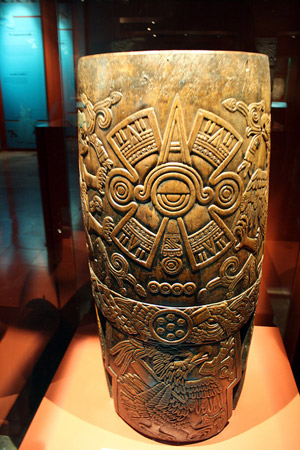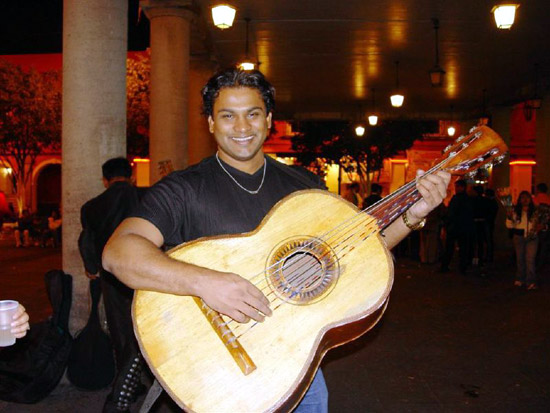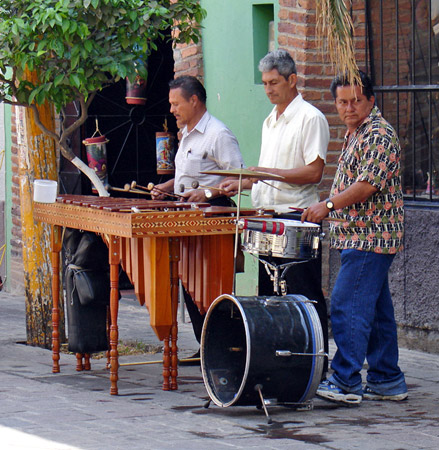Music: Instruments and Ensembles
Indigenous Instruments
Drums and percussion were the cornerstone of indigenous instrumentation. The Aztecs utilized a variety of drums ranging from turtle shells (ayotl) to hollowed logs (teponaztli and huehuetl). The latter were considered sacred and, while sometimes played as accompaniment, were often used alone for such purposes as leading warriors into battle. Rattles, sometimes fastened to sticks to form primitive maracas, were filled with pebbles or beads.
Flutes (huilacapitztli) made of various materials provided the melody, and still do for many ensembles performing indigenous music today. Other wind instruments included the conch (tecciztli) and snail horns (quihquiztli). Another instrument of note was the Yaqui Indians’ modification of the Mayan bubalek, hollow gourds struck while floating in water to creating an eerie, resonant sound.
Post-Colonial Instruments
Building on the foundation of standard European instruments like the trumpet, guitar, and violin, mariachi music acquired its signature sound upon inclusion of the vihuela (a round-backed, high-pitched 5-string guitar used for rhythmic layering and often rapid strumming) and the guitarrón (literally “large guitar,” a deeply bodied and voiced 6-string acoustic bass responsible for holding down the low end).
A Tradition of Guitars
Guitar relatives appear throughout the entire panorama of Mexican folk music, and include the guitarra de golpe, similar to the vihuela—both in structure and as a provider of chordal, rhythmic accompaniment—but slightly lower in pitch.
The bajo sexto is a 12-string instrument essential to norteño music, endowing a strong rhythmic foundation in the mid- to low range
The huapanguera, with 8 strings in 5 courses, a large resonating body and short neck, which takes on the role of a strummed rhythmic bass in son huasteco
The slightly brasher 12-string guitarra concherra, whose name (from concha, or “shell”) describes its shape, originated from the protective shield of the armadillo.
The jarana appears in two forms: the huasteco, the ukelele-sized, 5-string tenor accompaniment to the huapanguera in son huasteco; and the jarocha (meaning “from Veracruz”), carved from a single piece of wood with 8 strings in 5 courses, that provides harmonic support for the arpa jarocha in son jarocho.
The 4-stringed requinto jarocho is fashioned in the same way as the jarana jarocha, and despite a shallow body, it usually provides the syncopated, staccato bass lines of son jarocho.
Instrumental Imports
Another stringed instrument making major contributions to Mexican music is the violin, which shines especially brightly in son huasteco.
Equally emblematic is the accordion, the star of norteño music. On the button accordion, inherited from the Germans, the melody-side features rows of buttons rather than piano-style keys.
Banda Instruments
Bandas are constituted mainly of brass instruments, but also include woodwinds and percussion. From lowest to highest pitched, the brass consists of the sousaphone (often known also as the tuba); alto horns providing harmony; valve or slide trombones in the tenor range, covering the low end of melodic parts; and trumpets blasting out the higher voicings. Clarinets represent the soprano range and may follow the singing voices of the ensemble.
The tambora is a booming, double-headed membranophone with a fixed cymbal on its frame, approximating a drum kit (the old name for banda was indeed tambora, after this instrument, which traditionally had animal-skin heads). The percussion section is filled out by the tarola (snare drum), timbales (which approximate the tom-toms on a standard drum set), cowbells, and cymbals.
Article written for World Trade Press by Dan DeMento.
Copyright © 1993—2024 World Trade Press. All rights reserved.

 Mexico
Mexico 

